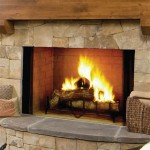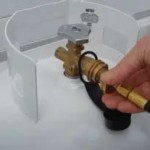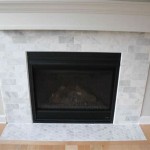How to Install Fireplace Door Gasket
Maintaining a fireplace's efficiency and safety relies heavily on its components, particularly the door gasket. A worn or damaged gasket allows air leaks, reducing the fireplace's heating effectiveness, increasing energy consumption, and even posing a potential safety hazard by allowing uncontrolled drafts or the escape of combustion byproducts. Replacing the fireplace door gasket is a relatively straightforward task that can significantly improve fireplace performance. This article provides a detailed guide on how to install a new fireplace door gasket, ensuring a proper seal and optimal fireplace operation.
Before beginning the installation process, it is crucial to gather the necessary tools and materials. These typically include:
- New Fireplace Door Gasket: Select a gasket with the correct diameter and length for the specific fireplace door. Refer to the manufacturer's specifications or the old gasket as a guide.
- High-Temperature Gasket Adhesive: Choose an adhesive specifically designed for fireplace gaskets, capable of withstanding high temperatures.
- Wire Brush or Scraper: Used to remove old adhesive and debris from the gasket channel.
- Utility Knife or Scissors: To cut the gasket to the required length.
- Gloves: To protect hands from adhesive and debris.
- Safety Glasses: To protect eyes from debris.
- Measuring Tape: To verify gasket length and ensure proper placement.
- Clean Rags: For wiping away excess adhesive and cleaning the work area.
Gathering these items beforehand ensures a smooth and efficient installation process.
Preparing the Fireplace Door Frame
The first step in installing a new fireplace door gasket involves preparing the door frame. This ensures that the new gasket will adhere properly and create a tight seal. Proper preparation is critical for the longevity and effectiveness of the gasket.
Begin by carefully removing the old gasket. This may involve pulling it out by hand or using a scraper or utility knife to loosen any stubborn sections. Be patient and avoid damaging the gasket channel during removal. The goal is to remove the old gasket without leaving behind excessive residue.
Once the old gasket is removed, inspect the gasket channel for any remaining adhesive, soot, or debris. Use a wire brush or scraper to thoroughly clean the channel, removing all traces of the old gasket material and adhesive. A clean surface is essential for the new adhesive to bond effectively.
After scraping, wipe the channel clean with a damp rag to remove any remaining dust or particles. Ensure the channel is completely dry before proceeding to the next step. Moisture can interfere with the adhesive's bonding properties.
Inspect the gasket channel for any damage, such as dents or rust. If any damage is present, attempt to repair it if possible. Minor imperfections can be filled with high-temperature sealant. However, extensive damage may require professional repair or replacement of the door frame.
Proper preparation of the fireplace door frame is paramount to ensuring a successful gasket installation. A clean, dry, and undamaged channel will provide the best possible surface for the new gasket to adhere to.
Applying the Gasket Adhesive and Installing the Gasket
With the fireplace door frame thoroughly prepared, the next step is to apply the gasket adhesive and install the new gasket. This requires careful attention to detail to ensure a proper seal and prevent air leaks.
Begin by applying a thin, even bead of high-temperature gasket adhesive to the gasket channel. Follow the manufacturer's instructions regarding application technique and drying time. Avoid applying excessive adhesive, as this can create a messy and uneven seal. A thin, consistent bead is sufficient.
Carefully press the new fireplace door gasket into the adhesive-lined channel. Start at one corner and work your way around the entire frame, ensuring the gasket is firmly seated in the adhesive. Apply gentle pressure to ensure good contact between the gasket and the adhesive. Avoid stretching the gasket during installation, as this can cause it to shrink and pull away from the adhesive over time.
As you install the gasket, pay close attention to the corners. Mitering the gasket at the corners can provide a cleaner and more professional look. Use a utility knife or scissors to carefully cut the gasket at a 45-degree angle before pressing it into the corner. Alternatively, simply overlap the gasket at the corners.
Once the gasket is fully installed, inspect the entire perimeter to ensure there are no gaps or loose sections. If any gaps are present, apply additional adhesive and press the gasket firmly into place. A continuous, unbroken seal is essential for preventing air leaks.
Use a clean rag to wipe away any excess adhesive that may have squeezed out from under the gasket. A clean finish will not only improve the appearance of the installation but also prevent the adhesive from attracting dust and debris.
Allow the adhesive to dry completely according to the manufacturer's instructions before closing the fireplace door. This drying time is crucial for the adhesive to fully cure and create a strong bond between the gasket and the door frame. Prematurely closing the door can disrupt the seal and compromise the integrity of the installation.
Proper application of the gasket adhesive and careful installation of the gasket are essential for creating a tight and effective seal. Taking the time to perform these steps correctly will ensure optimal fireplace performance and prevent air leaks.
Finishing Touches and Testing the Seal
After allowing the adhesive to dry completely, it is important to perform some finishing touches and test the seal to ensure the successful installation of the fireplace door gasket. These steps help to verify proper functionality and identify any potential issues.
Carefully close the fireplace door and inspect the seal around the entire perimeter. Look for any gaps or areas where the gasket is not making full contact with the fireplace frame. If any gaps are present, they may indicate insufficient adhesive or improper gasket placement. In such cases, additional adhesive may be required to fill the gaps and ensure a tight seal.
Perform a "dollar bill test" to further assess the seal's integrity. Place a dollar bill (or any thin piece of paper) between the fireplace door and the frame, then close the door. Attempt to pull the dollar bill out. If it slides out easily, the seal is not tight enough in that area. Repeat this test at various points around the door's perimeter. A properly sealed door will grip the dollar bill firmly, making it difficult to remove.
If the dollar bill test reveals any weak spots in the seal, carefully lift the gasket in those areas and apply additional adhesive. Press the gasket firmly back into place and allow the adhesive to dry completely before retesting. Multiple applications of adhesive may be necessary to achieve a perfect seal.
Once the seal is deemed satisfactory, clean the fireplace door and surrounding area to remove any remaining adhesive residue or debris. A clean fireplace will not only look better but also prevent the adhesive from attracting dust and soot.
Light a small fire in the fireplace and observe the draft. A properly sealed fireplace door should eliminate any uncontrolled drafts or air leaks around the door frame. If you notice any drafts, it may indicate a persistent gap in the seal that requires further attention.
Monitor the fireplace's performance over the next few uses. Pay attention to the efficiency of the fire and any signs of air leakage. If you experience any issues, such as difficulty starting a fire or excessive smoke entering the room, re-inspect the seal and make any necessary adjustments.
Proper finishing touches and thorough testing of the seal are crucial for ensuring the long-term performance and safety of the fireplace. Taking the time to perform these steps correctly will help to identify and address any potential issues before they become significant problems.
By following these steps carefully, installing a new fireplace door gasket can be a straightforward process that significantly improves fireplace efficiency, safety, and overall performance. Regular maintenance and timely replacement of the gasket will help to ensure years of comfortable and safe fireplace use.

Wood Stove Gaskets A Complete Guide Including Replacement

How To Replace A Wood Stove Door Gasket

How To Change Your Glass Gasket

Wood Stove Door Gasket Sealer Replacement Friendly Fires

Wood Stove Gaskets A Complete Guide Including Replacement

Easy Fireplace Insert And Wood Stove Gasket Finder

Woodstove Door Gasket Replacement An Easy Necessity

How To Replace A Door Gasket On Wood Stove
Rope Gasket For Schrader Fireplace Stove Hearth Com Forums Home

Wood Stove Door Gasket Repair Tiny
Related Posts








